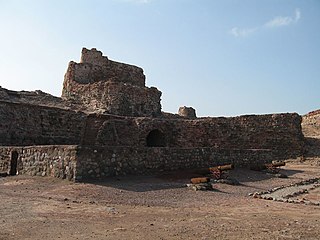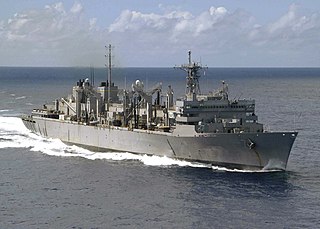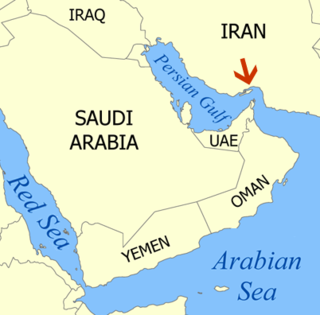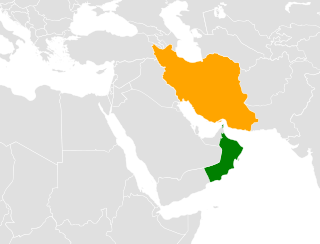See also
| This disambiguation page lists articles associated with the title Battle of the Strait of Hormuz. If an internal link led you here, you may wish to change the link to point directly to the intended article. |
Battle of the Strait of Hormuz or battle off Hormuz may refer to:
| This disambiguation page lists articles associated with the title Battle of the Strait of Hormuz. If an internal link led you here, you may wish to change the link to point directly to the intended article. |

The Strait of Hormuz is a strait between the Persian Gulf and the Gulf of Oman. It provides the only sea passage from the Persian Gulf to the open ocean and is one of the world's most strategically important choke points. On the north coast lies Iran, and on the south coast the United Arab Emirates and Musandam, an exclave of Oman. The strait is about 90 nautical miles (167 km) long, with a width varying from about 52 nautical miles (96 km) to 21 nautical miles (39 km).

The Kingdom of Ormus was a 11th- to 17th-century kingdom located in the eastern side the Persian Gulf and extending as far as Bahrain in the west in its zenith. The Kingdom was established by an Omani prince in the 11th century initially as a dependency of the Kerman Seljuk Sultanate, and later as an autonomous tributary of the Salghurids and the Ilkhanate of Iran. before becoming a client state of the Portuguese Empire, most of its territory eventually annexed by the Safavid Empire in the 17th century.

The Fifth Fleet is a numbered fleet of the United States Navy. It has been responsible for naval forces in the Persian Gulf, Red Sea, Arabian Sea, and parts of the Indian Ocean since 1995 after a 48-year hiatus. It shares a commander and headquarters with U.S. Naval Forces Central Command (NAVCENT) in Bahrain. As of 7 December 2018, the commander of the 5th Fleet is Vice Admiral James J. Malloy. Fifth Fleet/NAVCENT is a component command of, and reports to, U.S. Central Command (CENTCOM).

In naval warfare, the line of battle is a tactic in which a naval fleet of ships forms a line end to end. Its first use is disputed, variously claimed for dates ranging from 1502 to 1652, with line-of-battle tactics in widespread use by 1675.

USS Porter (DDG-78) is an Arleigh Burke-class destroyer in the United States Navy. Porter is the fifth US Navy ship to be named after US Navy officers Commodore David Porter, and his son, Admiral David Dixon Porter. This ship is the 28th destroyer of her class. Porter was the 12th ship of this class to be built at Ingalls Shipbuilding in Pascagoula, Mississippi. She was laid down on 2 December 1996, launched and christened on 12 November 1997, and commissioned 20 March 1999, in Port Canaveral, Florida.

In military strategy, a choke point is a geographical feature on land such as a valley, defile or a bridge or at sea such as a strait, which an armed force is forced to pass, sometimes on a substantially narrower front and therefore greatly decreasing its combat power, to reach its objective. A choke point can allow a numerically inferior defending force to thwart a larger opponent if the attacker cannot bring superior numbers to bear.

Countdown to Looking Glass is a Canadian made-for-television movie that premiered in the United States on HBO on October 14, 1984 and was also broadcast on CTV in Canada. The movie presents a fictional confrontation between the United States and the Soviet Union over the Strait of Hormuz, the gateway to the Persian Gulf. The narrative of the film details the events that lead up to the initial exchange of nuclear weapons, which was triggered by a banking crisis, from the perspective of an ongoing news broadcast.

Hormuz Island, also spelled Hormoz, is an Iranian island in the Persian Gulf. Located in the Strait of Hormuz, 8 kilometres (5 mi) off the Iranian coast, the island is part of Hormozgan Province.

The Fort of Our Lady of the Conception, also known as the Portuguese Castle, is a red stone fortress on Hormuz Island, Iran. It is one of the last surviving monuments of Portuguese colonial rule in the Persian Gulf. Ormuz was an important maritime city and a small kingdom near the entrance to the Persian Gulf. The original site of the city was on the north shore of the Gulf, about 30 miles east of the current Bandar Abbas. Around 1300, apparently in response to attacks from the Tartars, it moved to the small island of Gerun, which can be identified as the Organa of Nearcho, about 12 miles west and 5 miles from the coast.

USNS Rainier (T-AOE-7), is a Supply-class fast combat support ship and the third US Navy vessel named after Mount Rainier. The ship was christened on 28 September 1991 by the ship's sponsor, Mrs. Suzanne Callison Dicks, wife of Congressman Norm Dicks, and commissioned as "USS Rainier (AOE-7)", on 21 January 1995 at Bremerton, Washington.

In the 1622 Capture of Ormuz an Anglo-Persian force combined to take over the Portuguese garrison at Hormuz Island after a ten-week siege, thus opening up Persian trade with England in the Persian Gulf. Before the capture of Ormuz, the Portuguese had held the Castle of Ormuz for more than a century, since 1507 when Afonso de Albuquerque established it in the Capture of Ormuz, giving them full control of the trade between India and Europe through the Persian Gulf. "The capture of Ormuz by an Anglo-Persian force in 1622 entirely changed the balance of power and trade".

The Capture of Ormuz in 1507 occurred when the Portuguese Afonso de Albuquerque attacked Hormuz Island to establish the Fortress of Ormuz. This conquest gave the Portuguese full control of the trade between India and Europe passing through the Persian Gulf.

The Persian–Portuguese war took place between 1507 and 1622 and involved the Portuguese Empire and its vassal, the Kingdom of Ormus, on one side, and the Safavid Empire of Persia with the help of the Kingdom of England on the other side. During this era, Portugal established its rule for about eighty years in Ormuz and Bahrain, capturing some other islands and ports such as Qeshm and Bandar Abbas for few years. The conflict came to an end when the Safavid Shah, Abbas I of Persia, conquered the Portuguese territories forcing them to leave the Persian Gulf.
Capture of Ormuz may refer to:

The Strait of Hormuz dispute is an ongoing dispute between a coalition of countries and Iran. The dispute arose on 27 December 2011, when Iranian Vice President Mohammad-Reza Rahimi threatened to close the Strait of Hormuz. In late April 2019 Iran said that it will block any shipping if it was barred from using the strategic waterway and in face of US sanctions
National Persian Gulf Day is an official holiday in Iran that takes place on the 10th of Ordibehesht, the second month on the Iranian calendar – usually occurring on 30 April on the Georgian calendar – to commemorate, not the Persian Gulf itself, but rather the name, which carries historical significance. The date coincides with the anniversary of Abbas I of Persia's successful military campaign when the Portuguese navy was driven out of the Strait of Hormuz in the Capture of Ormuz (1622). The decision was taken by the High Council of Cultural Revolution, presided over by former President Mohammad Khatami, noting that the campaign launched by certain Arab states to rename Persian Gulf was the driver behind the decision. The Iranian postal authority has issued a series of stamps commemorating the day.
Belchior Calaça was a Portuguese naval captain who was active in the Indian Ocean in the second half of the 16th century.

Iran–Oman relations are bilateral relations between Oman and Iran. The two countries currently share diplomatic and economic ties dating back to the Pahlavi period. Oman considers Iran not to be a threat perceived by the other Arab states of the Persian Gulf. Both countries are members of the Organisation of Islamic Cooperation, the Non-Aligned Movement and the Group of 77. Iran has an embassy in Muscat whilst Oman has an embassy in Tehran.

The Battle of the Strait of Hormuz was fought in August 1553 between an Ottoman fleet, commanded by admiral Murat Reis, against a Portuguese fleet of Dom Diogo de Noronha. The Turks were forced to retreat after clashing with the Portuguese.
The battle off Hormuz on 11–12 February 1625 was "perhaps the largest naval battle ever fought in the" Persian Gulf. It pitted a Portuguese force against a combined force of the Dutch East India Company (VOC) and English East India Company (EIC). Although the battle was a draw, the result was the loss of Portuguese influence in the Gulf.